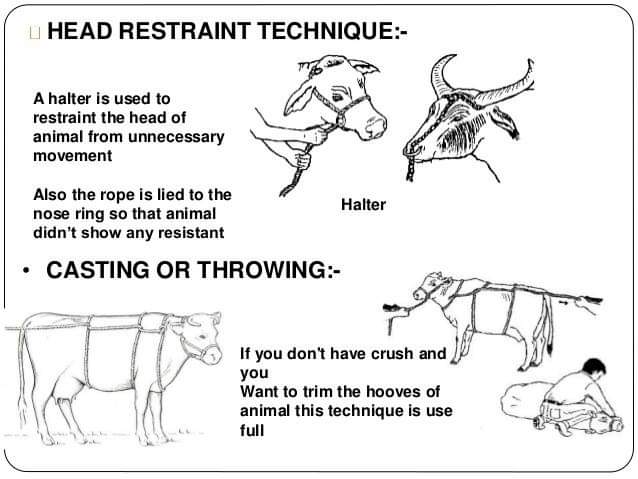HANDLING & RESTRAINING TECHNIQUES OF FARM ANIMALS
Animal restraint is the process of preventing an animal or group of animals from action or motion, for example flight or attack for various purposes. An animal may require restraint for examination, treatment, milking etc. Restraint can be achieved simply by moral persuasion or by physical force or by chemical means. Most of the restraint methods that employ physical force or the use of cane have been outmoded being unnecessarily difficult and dangerous to the handler and the animal.
Animal Handling Skills-Professionalism and Safety
The public watches us to learn how to properly handle animals.
Being professional means being SAFE and HUMANE.
Good animal handling skills prevent staff from being injured.
Good animal handling skills reduce stress for the animal.
Examples of Safe Animal Handling:
Be aware of the special stressors for animals in the clinic setting.
The clinic is extremely chaotic for any animal-there are an incredible number of smells
and other stimuli and animals are likely to be confused and distressed.
Many of our patients have lived entirely outdoors and have not been handled or examined
before. They may not have any experience on a leash and may panic in response.
Even the most social animal may exhibit aggression toward other animals, particularly in a
strange environment and may redirect to nearby people when over-stimulated.
Never put your face directly into the face of a dog or cat.
Do not move in behind or crowd around a dog.
Concentrate on the animal you are handling without being distracted by other activities.
NEVER sit on the floor while handling/examining a dog. If the animal becomes aggressive or aroused you will be unable to move away or protect yourself and risk serious facial bites.
Always be prepared to protect yourself or move away quickly in the event an animal becomes aggressive unexpectedly.
Safe and effective animal handling requires a thorough understanding of the normal behavior and responses of each species. Below is some general information on animal behavior and handling techniques. There is no substitute, however, for careful observation and experience
If there is any doubt about the temperament of an animal-ASK FOR ASSISTANCE. There are no extra points for being a ‘hero’. The safety of our staff and patients is most important!
Communication
Any animal exhibiting potentially aggressive behavior should have a kennel sign (CAUTION) posted to alert others who may be handling the animal. Specific alerts or recommendations should be written on the sign and in the medical record to provide staff and other volunteers with as much information as possible when handling the animal.
Restraint or Control
The first rule to keep in mind when handling any kind of animal is that the least restraint is often the best restraint. This does not mean that you give up your control, just that you use as little restraint as
necessary while maintaining control of the situation. Every animal and every situation is different so there are no hard and fast rules as to what method works best in which situation.
Before attempting to restrain an animal you should take a moment to allow the animal to become comfortable with you:
Crouch down so that you are on their level. Do not sit on the ground as you will be unable to move away or protect yourself if necessary.
Avoid direct eye contact but maintain safe visual contact with the animal
Talk in soothing tones. Avoid high-pitched, excited talk.
Try patting your leg or the ground, motioning the animal towards you.
TYPES OF RESTRAINT
VERBAL RESTRAINT:
Many dogs know some commands or can at least recognize authority, even if the command is unfamiliar. Commands such as SIT, STAY, COME, DOWN, NO or even HEEL may be useful tools to encourage a dog to cooperate. Also, soft quiet words can calm a frightened animal. Yelling or screaming should
never be used as it can cause the animal to become more fearful or aggressive.
PHYSICAL RESTRAINT: TOOLS AND EQUIPMENT
Leash: The most common tool used to handle animals in the clinic is the leash. Placed around a dog’s
neck it normally controls even the largest dog. In the event a dog refuses to cooperate with a leash –
carry him. Some dogs have never seen a leash and will freeze up to the sensation around a sensitive
area like the neck. Leashes can be abused; never drag or strangle an animal with a leash; if the animal
starts to struggle, pulling and jerking away from you, she is probably not leash trained. Pause and let the
dog calm down and try again after reassuring her. Sometimes a quick tug on the leash will encourage a
fearful dog to walk. If the dog refuses to walk, apply a muzzle (if necessary) and carry her.
When handling cats, a leash should be used as a back-up in the event the cat should become frightened and resist restraint. Make a figure-eight harness by looping the free end of a slip lead back through the metal ring. The looser loop is placed around the chest behind the cat’s front legs and the other loop
placed around the neck with the metal ring/handle on top between the shoulders. This will prevent the cat from escaping or injuring someone should she get loose from your restraint. The harness should be put on at intake and can be left on the cat throughout their stay.
EVERY animal being transported or handled in the clinic must ALWAYS wear a slip-lead. This
includes puppies, cats and sedated animals. It is too easy for a frightened animal to get loose and
escape. Animals presented on leash/collar should be transferred to a slip lead and the leash returned to the client so that it is not lost during the animal’s stay.
Your hand: A very effective form of restraint, your hands are sensitive to the amount of pressure that is
being exerted on the animal and can be quickly modified to the situation. Hands can be used to gently
stroke a dog or to firmly grasp a struggling cat. Although hands can be the most versatile, they are also
the most vulnerable to injury. Recognizing when they would not be effective is very important.
Towels: A towel or blanket is a very useful tool for cats and small dogs. A towel can be used to
decrease an animal’s arousal by covering the head and body and can help protect from sharp claws.
Come-a-long or control pole: The control pole is used to safely handle extremely aggressive dogs.
Used appropriately it is an effective tool. Inappropriate or unskilled use can cause serious injury to the
animal. The control pole may further distress an upset animal and should only be used when the handler
or other’s safety is genuinely threatened. Volunteers are NOT to use the control pole unassisted. If an
animal is aggressive enough to warrant the use of a control pole an experienced staff member should be
consulted for assistance as the animal will also be evaluated for chemical restraint options.
Nets: The net is the primary tool used to handle fractious cats or wildlife. It allows for the safe handling
and transfer of even the most aggressive small mammal. Effective use of the net requires some training
and practice. If you need to handle a feral or fractious cat ask for assistance from a staff member.
Muzzles: Muzzles are used when a snappy or potentially aggressive dog must be handled. There are
nylon muzzles and plastic basket available. A leash or strip of rolled gauze can be used as a temporary
muzzle. Because dogs often try to remove a muzzle, it is important that the muzzle be placed securely.
A weak or poorly made muzzle may lead to a false sense of security and the possibility of being bitten.
Even with a securely placed muzzle, appropriate handling must be used to prevent injury from an animal
who resists.
Muzzles designed for cats extend up to cover the eyes, reducing visual stimulation. For some cats these can be very useful for calming the animal and helping to protect the handler from injury,
Drugs: For animals who are too aggressive or stressed to handle safely for procedures, sedation and/or general anesthesia may be necessary to allow treatment. If you are unable to handle an animal, notify a staff member to determine whether sedation is appropriate.
When receiving an animal for surgery who exhibits difficult or aggressive behavior consult the Anesthesia Lead prior to kenneling the animal as we may opt to administer a pre-anesthetic sedative immediately and expedite the surgery process to minimize the animal’s time in the clinic.
Credo: Never Let Go.
The place where correct use of restraint is the most critical is when two people are handling the animal.
This could be to perform a physical exam, administer anesthetic or to give medications. The “holder” is
the person whose job it is to restrain the animal in such a way that the procedure can be accomplished
with the least amount of stress to both handlers and animal. The specific amount of restraint used to
control the animal is the key to safety for the handlers and comfort for the animal. Too much restraint
can cause the animal to fight back, too little restraint can result in the handler or others being injured or in
the animal escaping.
APPROACHING AND HANDLING OF CATTLE
• The usual practice is to tie the cows in double or single row in byres the cows are approached from the right side in byre.
• The terms near and off are not applicable to cattle.
• To examine the head of a horned cow, the assistant standing near the animal should first grasp the horn and the nostrils are held thus keeping the head straight.
• The horns are always secured before taking hold the nostrils.
• Bull holders or bull dogs may be applied to the nostril and then restrained.
• In every case, it is best to talk to it and pat its back while approaching it.
• To restrain a bull pole or bull leader may be used. Generally bulls should be secured before approaching.
• Ropes may also be used instead of pole. A halter may also be applied. Sometimes a bull mask may be used.
• A bull mask may be useful in preventing them from seeing straight. It is made up of stout leather and a thin piece of metal sheet.
• It rests on the front side of the face, and is kept in the place by a noseband and with the help of two straps bucked around the horn.
SIMPLE RESTRAINT OF CATTLE
• Nose Ring
• Milkman’s rope
• Bull holders
• Bull leader
• Nose String
• Udder kinch
CASTING OF CATTLE
• Reuffs method
• Indian method
Reuffs method
• A running nose is made at the end of at 30’ rope and passed round the base of the horses.
• A half hitch is next made round the neck a second round the chest immediately behind the elbows and a third round the abdomen infront of the udder or scrotum.
• The rope is pulled by two persons.
Indian method
• A long rope about 30’ in length is taken and a loop is made.
Casting animals
Precautions before casting:
- Fast an animal for up to 12 hours before casting. If the animal has a full stomach, it may rupture during casting.
- There should be sufficient labor available to complete the manoeuvre in the shortest time with the least distress to the animal. It is necessary to have a reliable person at the animal’s head in order to control it. Depending upon the size of the animal that must be cast, either two or three persons are needed to pull on the rope.
- The site for casting should be chosen carefully. The best choice is a well=grassed field where there is sufficient space and no objects which could cause injury. In bad weather a barn is suitable. There should be plenty of clean straw put down to make the animal’s fall as comfortable as possible.
- A strong webbing halter or head collar must be used. There must not be a bit in the horse’s mouth and any twitch that has been used in adjusting ropes must be removed.
- Any operations on the feet necessitate the removal of shoes. This is particularly necessary if hobbles are to be used in casting.
Casting Cattle and Buffaloes:
Cattle and buffaloes are cast for a variety of reasons: surgical operations, trimming of feet, and better control at a difficult calving. The most common and efficient method of cassting cattle and buffaloes is Reuff’s method.
Reuff’s method of casting cattle and buffaloes minimized the chances of injuring either the animal or people attending it. A running noose is made at one end of a 10 m long rope and passed around the base of the horns. In the case of polled animals, the noose can be placed around the neck. A half hitch is made around the neck, the second around the heart girth, and passed back and looped around the animal just behind the hip bones. A steady pull on the free end will cause the animal to collapse slowly. It is advisable to cast the animal on soft grass or a bed of hay or straw.
An alternative method is shown in figure, in which middle of the rope is placed over the neck and the ends passed between the front legs. They cross under the brisket, are passed upward and crossed over the back and then downwards past the flanks and between the hind legs. Traction on the free ends will then cause the animal to collapse. The ropes must cross under the brisket (Not on the throat), or the animal will not go down.
One great advantage of the latter method is that, because there are no knots involved, it is easier to remove the rope when you are finished with the animal. With Reuff’s method, the rope tends to stay in a better position. This is an advantage when casting wild or excited cattle because the rope can be put on in the crush. The animal is then let out of the crush and the process of casting can begin.
Casting is not recommended for pregnant animals because of the possibility of abortion. It can also result in bloat, pneumonia, or displacement of the abomasum.
BASIC ROPE WORK
Before you attempt to restrain an animal, especially large animals, you must be familiar with basic rope work. You should be able to tie quickly the commonly used knots. You can easily learn about knots which are essential for day-to-day usage from an experienced friends or animal health attendants.
The bowline knot is one of the most useful of all knots. It never slip and therefore can be used to make a loop or noose, which will not ‘draw down’or tighten on the neck of your animal
Cattle restraint techniques are designed to divert attention from where you want to treat and prevent kicking and make possible some special procedure.
- Nose Lead technique Lift the animal’s head fairly high and pull towards the side opposite that on which you intend to work. Apply pressure on the
bridge between the nostrils to cause temporary pain in the sensitive tissues between the nostrils. - Heads Restraint technique
Manually grasp the bridge between the nostrils with the thumb and forefinger of one hand and hold it firmly. With the other hand, hold the horn rear. - Ear twitch technique
Ear twitches are easy to make and are very effective. On a one foot length of a strong bar tie the lose end of 1.5 feet length of soft rope. Apply and twist the twitch on the ear lobe carefully and firmly to exact little pressure on the ear lobe. Apply enough pressure only to elicit pain that can divert the animal’s attention. Always treat the ear lobe with caution so as not to damage the ear cartilage. - Milking Hopples technique
Apply the figure “8” just above the hock to prevent kicking while milking. Hock twitch is the milkers delight. It prevents a cow from raising the rear legs and thus prevents kicking. It is simple and effective. Get a rope made of heavy cotton between 18-22 inches around the hind legs just above the hock joint in figure of “8” pattern crossing between the two legs. Astrong stick or piece about a foot long is put through the eye by turning the stick, the rope is twisted until it binds
the legs tightly and presses the tendon down. Thus it prevents the animal raising its legs and make milking possible. - Legs raising technique
First apply a nose lead. Grasp the legs at the pastern with the left hand, With the left shoulder push the cow’s flank to shift her leg to the other near legs, at the same time raise the rear leg. - Tail restraining technique Your assistant may apply the tail restraint whenever it is necessary to distract cow’s attention from another part of her body on which work is being done. It may be used when giving udder injections to a nervous cow. Keep both hands close to the base of the tail as much as possible. Stand to the side of the cow to avoid being kicked and apply a lifting force on the tail. It should be gentle but firm
- Crush restraining technique
If many adult cattle are to be confined at a time, a crush is most advised. Get the entire animals close together. Use the person most familiar with the cows to go close to them then to the animal in question. It is always advisable to hold a long rope that has a loose note at one end. Go as close to the cattle as possible and get the rope into the head or horns. With the rope in place it will be easier to lead and finally restrained. - Calves restraining technique Reach across the animal’s back and pull the legs on the side closest to you outward. Calve is then eased down to the ground with the weight against your legs, so that it falls to the ground gently. You should never cast a calf by pulling its leg quickly from under its body so that he falls hard on its side. Avery young animal, it may be injured in that way.
Keep your knees against the calf’s back to hold it down. Place the center of your rope over its back legs. Bring both ends back between the legs, cross the two ends and carry them between the front legs. Take the rope over the back of the neck. Getting the children of the herds men to catch them best does catching the calf in the open. Again catching calves at the head or hind legs is best. Like adult cattle, calves are best caught amidst themselves. - Heifers restraint technique
Persons most familiar with them best, restrain the heifers. With one hand hold a horn or the ear. Hold the ear at its base and apply all the pressure of your hand against the headThe ear should merely pass between the thumb and forefinger and should not be squeezed. Place the other hand under the heifer’s chin, grip the lower lip and hold her head steadily against your hip. The heifer can then be examined or treated.
How to make temporary halter.
The temporary halter is used when a permanent halter is not available.
To make halter, loop the rope around the cow’s neck and secure the loop with a bowline knot. Make a bight in the standing long part of the rope. Pass the bight through the loop and over the nose.
HANDLING AND RESTRAINING A SHEEP OR GOAT
• The easiest way to catch an animal is bring it with food.
• If this fails a group of animals can be herded to a pen or enclosure from which the individual animal can be caught.
• This is done by approaching from the side and catching the horns, legs or neck usually succeeds.
• The sheep or goat can be man handled to a sitting position by reaching under the belly and gently holding the hind leg.
• In general it is always easier to catch one in group than an isolated individual.
• The lamb or kid alone in a pen is usually very nervous and may become berserk and injure itself by running in to the fences.
• The best way to hold the animal is by grab the loose skin in the right hind flank if you are a right handler and vice versa if you are a left handler.
• Hold the skin firmly and lift upward to control the sheep. To move a sheep hold it by the skin under the throat and place the other under the dock.
• Lift up on the dock and the sheep will move. Carrying a lamb and letting her follow can usually accompany moving an ewe and her lamb into a lambing pen
• Sheep are held above the hock or placing the left hand underneath the jaw and around the back. Horned sheep can be held by the horns.
• When holding a sheep, stand on its left side and place the left hand under its jaw, the right hand should reach well under the belly.
• To turn up a sheep, the attendant should stand against it left side placing his left hand under its neck.
• Pass your right hand over the right flank as far under the belly as possible and take hold of the wool.
• Raise the sheep’s fore legs off the ground with the right hand lift the animal into a sitting position infront of the shepherd legs and supported.
• In horned breeds to avoid injury and to have better control, the horns are held instead of the fore limbs
RESTRAINING TECHNIQUE FOR PIGS
Pigs are stubborn animals. They have definite ideas of their own and are extremely individualistic. Every pig is different from the other. What apply to one may not apply to the other in the same pen or herd. Pigs may look hard to you in appearance, they are not strong enough when you subject them to rough handling especially the way you do to ram and goats. Also the legs are thin and rather fragile when you use catch and restrain a pig for a very long time. Pigs are not gentle either. Even the piglets are capable of biting your fingers off if you frighten them. As a rule make pigs as comfortable as possible even under restrain. When large herds are to be controlled, it is advisable to have their pen as clean and dry as possible. The Pen should be in order several days before they are handle. If the pen is clean and fresh beddings supplied and the Pigs have a dried up environment and they will be easier to maneuver. Pig can be restrained by two methods
(A) Catching method
1.Hurdling: Trap the pigs between solid barriers to restrict movement of the pigs. Catch the large ones among
the pigs with pig catcher rope when trapped. It is advisable to handle young one with care in other not to cause dislocation of the bones.
2.Trap or confinement Individual pigs may be driven into confinement and selectively restrained with effective use of rope.
3.Pig Catcher Catch the rear legs in the clamp of the pig catcher and pull the rope to hold it, tight around the legs.
4.Use of Bucket Move a large pig covering its face with buckets and moving it in the reverse direction.
5.Snubbing rope The rope behind the tusks is snubbed to a post as the pig pulls back.
(B) Special restraint method
1.Hug snare twitch The twitch used for pigs is usually made up of a very long pole with a wire loop. Place the twitch over the upper jaw behind the tusks and apply gentle but firm pressure that is painful enough to prevent resistance or backward movement.
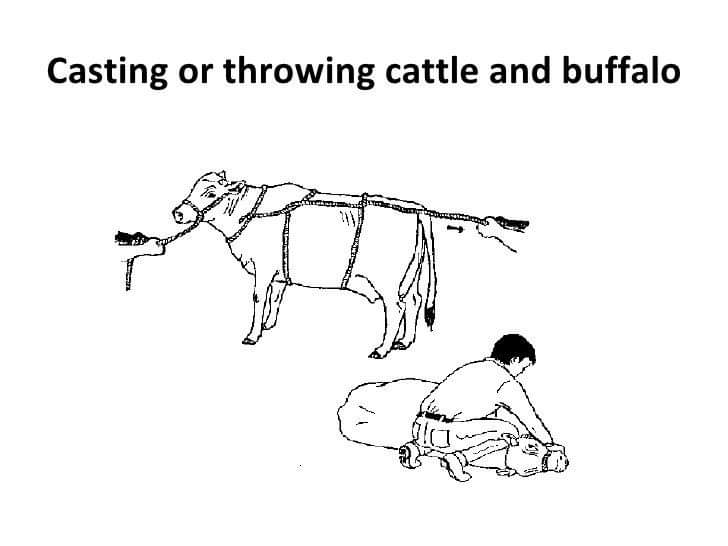
DOG RESTRAINING TECHNIQUES
Dogs are companion animals. They are part of the family as such they should be calm, friendly and completely trustworthy in your own hand. They should equally be trained to obey your voice and take instruction with ease. You should as a matter of fact be able to carry out some basic restraint on them without injuring yourself or the dog. If you train your dog well enough, they should obey you. However, you should be careful never to surprise a dog. You should be sure that the dog not only sees you approaching but hears you as well; especially when a stranger is to assist you attend to your dog. You should always watch for indications of the mood of your dog before you do anything. Do not take the unawares or by surprise.
POULTRY RESTRAINTS
Carrying a Large Turkey
A Large turkey can be carried as illustrated below. Their wings are held against its body so that it is they are unable to flop its wings. Part of the weight is supported on your hip. Both legs are held firmly in one hand.
Turkey’s breast can be supported on the table and its legs pulled backward and held with one hand. The bird is held securely, body well balanced, and rest calmly on the table.
Holding a small Bird
Pigeons, Quail and other small birds should be picked up and held in one hand.. The finger should be extended across the birds back to hold down both wings. When transporting small birds for long distances, they should be in cages. Don’t carry small birds by the wings. Never use bird’s wing as Handles. The wings are fragile and can easily be fractured. The wings can only be used to lift birds. The wings are so large and handy that it is tempting to use them as handles. This temptation should be resisted.
(DETAILS OF RESTRAINING OF DOGS WILL BE POSTED SUBSEQUENTLY)
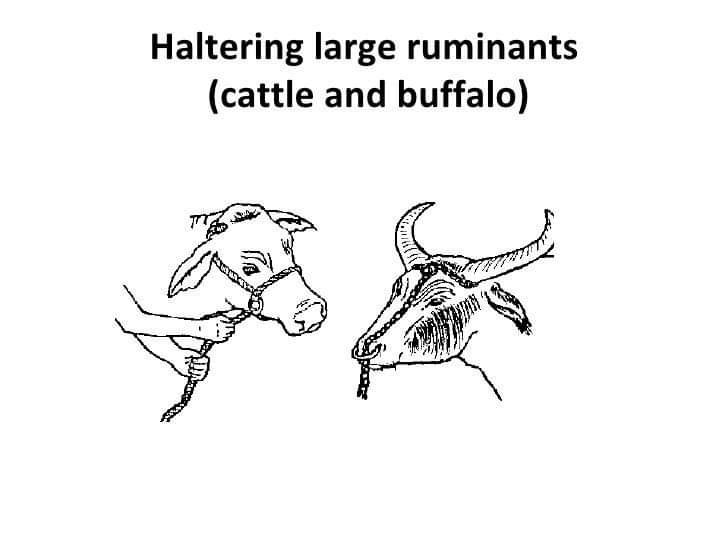
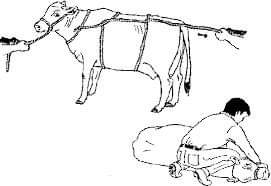
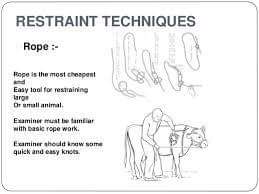
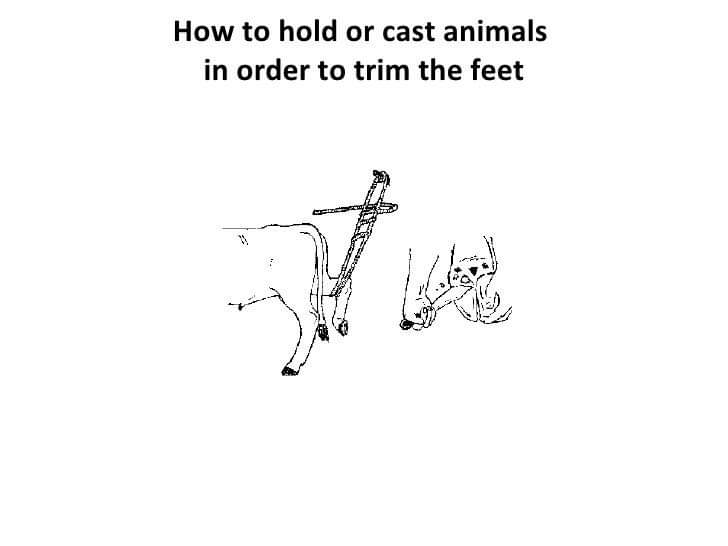
Reference-On Request
Compiled & Shared by- Team, LITD (Livestock Institute of Training & Development)
Image-Courtesy-Google
Reference-On Request.


